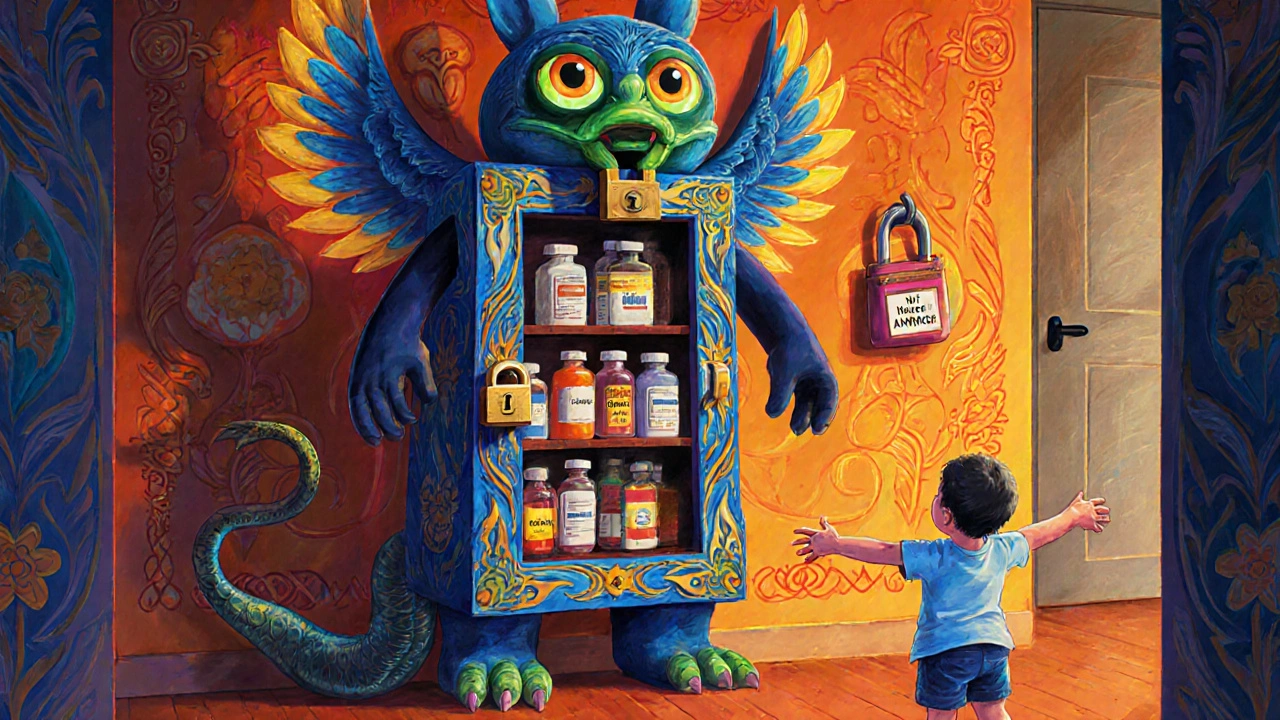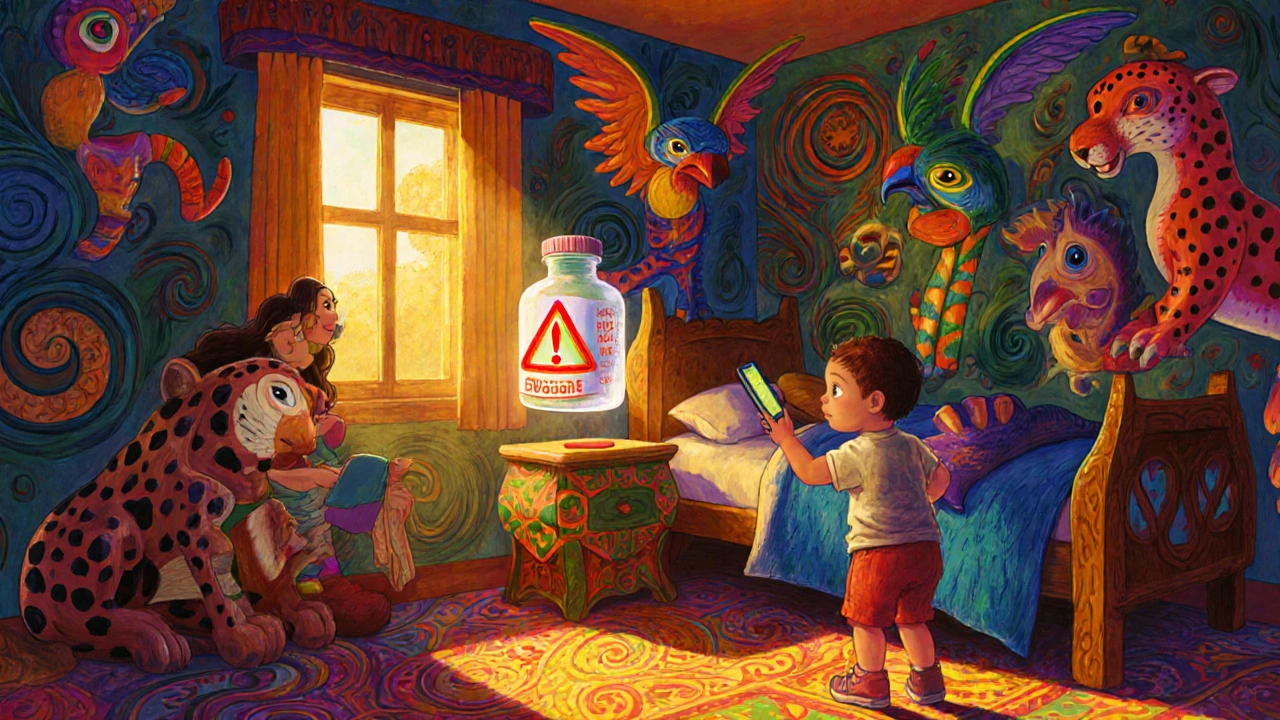Most kids who swallow medicine by accident don’t do it in the middle of the night.
They do it while you’re distracted-maybe you’re answering a text, loading the dishwasher, or letting Grandma hold the baby. That’s when the pill bottle left on the nightstand, the cough syrup in the purse, or the gummy vitamins on the counter become a deadly snack. In the UK, more than 1,000 children under five are taken to A&E every year after swallowing medicine that wasn’t meant for them. And the worst part? Almost all of these incidents happen in homes that feel safe.
Medicines aren’t candy. Never say they are.
It’s tempting. You’ve got a fussy toddler who won’t take their medicine, so you say, “This is like candy!” or “It tastes like gummies!” But research shows this single phrase makes kids 3.2 times more likely to grab medicine on their own. The brain of a two-year-old doesn’t understand the difference between “tastes sweet” and “only for sick people.” To them, sweet = food. And food = okay to eat.
Instead, say: “This is medicine. It helps you feel better, but you can’t have it unless Mommy or Daddy gives it to you.” Say it calmly, every time. Consistency matters more than you think.
Lock it up-really lock it up.
High shelves? Not enough. Child-resistant caps? Not enough. Even the most “safe” medicine bottle can be opened by a determined 18-month-old. I’ve seen toddlers climb onto the toilet seat, then onto the sink, then pull down a purse from a hook. They’re faster and stronger than you expect.
Here’s what actually works:
- Store all medicines-prescription, OTC, vitamins, e-cigarette liquids-in a locked cabinet. Magnetic locks that require two hands to open are best.
- Put the cabinet at least 54 inches off the floor. That’s beyond the reach of most toddlers, even if they stand on a chair.
- Use automatic-locking latches that click shut when the door closes. Don’t rely on just pulling the door shut. Kids learn to push, pull, and twist.
- Keep meds out of purses, coat pockets, bedside tables, and kitchen counters. Thirty percent of poisonings come from visitors’ belongings. Grandparents don’t mean to leave things out-they forget. But your child doesn’t forget.
Keep everything in the original bottle.
Transferring pills into a pill organizer, a Tupperware container, or a snack bag might seem convenient. But it’s dangerous. One in four poisonings happens because the medicine was moved from its original packaging. Kids don’t know what “ibuprofen” looks like-but they know the bright blue bottle with the child-resistant cap. When you remove that label, you remove their only warning.
Also, never use empty food containers for medicine. A yogurt tub with liquid medicine inside? That’s a toddler’s new juice box. A candy box with pills? That’s a snack.
Use the right measuring tool-no spoons.
Using a kitchen spoon to measure medicine is one of the most common mistakes-and one of the most dangerous. A teaspoon isn’t always 5ml. Some are 3ml. Others are 7ml. A 20-40% dosing error can turn a safe amount into an overdose. Acetaminophen (Tylenol) is the most common poison in kids under five. Too much can cause liver failure. Too little, and the fever won’t break.
Always use the measuring tool that came with the medicine: a syringe, a dosing cup, or a dropper. If you lost it, ask your pharmacist for a new one. They’ll give you one for free. And mark the correct dose with a piece of tape so you don’t guess next time.

Watch out for these hidden dangers.
Not all dangerous medicines come in bottles.
- Liquid nicotine (e-cigarettes): Just half a millilitre can kill a toddler. Store these like you would bleach-locked, high, and out of sight.
- Transdermal patches: Fentanyl or nicotine patches stuck to skin can be peeled off and chewed. Keep them sealed in their foil packets until use, and dispose of used ones by folding them in half with the sticky side in, then putting them in a locked trash bin.
- Supplements: Iron pills look like candy. One can cause severe poisoning in a child. Store them separately from vitamins.
Think ahead-kids grow fast.
When your child starts pulling up on furniture, you think, “They’re not climbing yet.” But in three months, they’ll be standing on the couch. In six months, they’ll be reaching for the top shelf. Don’t wait until they’re climbing to lock things up.
Plan ahead. Every time your child hits a new milestone-crawling, standing, climbing-do a quick safety check. Get down on your hands and knees. Look around the room from their eye level. What can they reach? What’s within arm’s length? That’s your danger zone.
Post the Poison Help number-everywhere.
Every home with young kids needs the Poison Help number posted where everyone can see it: fridge, next to the phone, on the bathroom mirror. The number is 1-800-222-1222. It’s free, available 24/7, and staffed by nurses and pharmacists trained in poison emergencies.
Here’s why this matters: Homes with the number posted respond 47% faster in emergencies. And if you call within five minutes of exposure, the chance of a serious outcome drops by 89%. Don’t wait to see if they’re “okay.” Don’t Google it. Call immediately.
Teach visitors. Seriously.
Grandparents, babysitters, friends-they mean well. But they don’t know your rules. They leave pills on the counter. They give medicine from their own bottle because “this one worked for me.”
Before anyone comes over, say: “We’ve had a close call before, so we keep all medicine locked up. Could you please keep your purse, coat, and bag off the floor?” Offer them a hook or a high shelf. Most people will say yes. And if they don’t? It’s better to be safe than sorry.

Practice CPR and the Heimlich maneuver.
Most poisonings don’t require emergency transport. But 12% of severe cases need immediate action before help arrives. If your child is choking, unconscious, or having trouble breathing, don’t wait. Start CPR. Do the Heimlich if they’re choking on a pill.
Take a free online course from the British Heart Foundation or sign up for a local session at your community centre. You won’t need it often-but if you do, you’ll be ready.
What to do if your child swallows medicine
Stay calm. Panic slows you down.
- Don’t make them vomit. That can cause more harm.
- Check the label. What did they take? How much? When?
- Call 1-800-222-1222 immediately. Have the medicine bottle ready.
- Follow their instructions. They might tell you to wait, to go to the hospital, or to watch for symptoms.
- Bring the bottle with you if you go to the ER.
Real change starts with small habits
There’s no magic solution. No app or gadget will fully protect your child if you don’t change your daily habits. But small, consistent actions add up. Locking the cabinet. Using the syringe. Saying “medicine, not candy.” Posting the number. These aren’t just tips-they’re lifelines.
One parent in Manchester told me she started locking her meds after her neighbour’s toddler swallowed a whole bottle of children’s ibuprofen. The child survived, but spent three days in intensive care. She now keeps her cabinet locked even when she’s home alone. “I don’t want to be the one who thought, ‘It won’t happen to me,’” she said.
It’s not paranoia. It’s protection.
You’re not being overprotective. You’re being smart. Accidental poisoning isn’t rare. It’s preventable. And the tools to stop it are simple, cheap, and already in your home.
Can child-resistant caps really keep kids from getting into medicine?
No. Child-resistant caps are designed to slow down adults who aren’t paying attention-not toddlers. Studies show that 1 in 4 children under 5 can open these caps within minutes. They’re a backup, not a solution. Always combine them with locked storage.
What if my child swallows medicine but seems fine?
Call Poison Help (1-800-222-1222) anyway. Some medicines, like acetaminophen or antidepressants, don’t cause symptoms right away. But damage can start within hours. Waiting to see if they “look okay” can delay life-saving treatment.
Are there free lock boxes available for families?
Yes. Many community pharmacies and children’s hospitals offer free medication lock boxes to families with toddlers. Ask at your local pharmacy or check with your GP’s office. Some NHS programmes even provide them through child health visits.
Is it safe to store medicine in the bathroom?
Not if it’s in a cabinet above the sink. Humidity can weaken pills and liquids. And toddlers can easily reach them. The best place is a locked cabinet in a bedroom or hallway, away from moisture and out of reach.
What’s the most dangerous medicine for toddlers?
Acetaminophen (Tylenol) and ibuprofen (Advil, Motrin) are the most common, but liquid nicotine from e-cigarettes is the most deadly. Just a teaspoon can be fatal. Keep all nicotine products locked up, even if you don’t smoke.
Should I keep an antidote at home?
No. There’s no universal antidote for poisoning. Activated charcoal is not recommended for home use and can be dangerous if misused. Your best tool is the Poison Help hotline. They’ll tell you exactly what to do.

